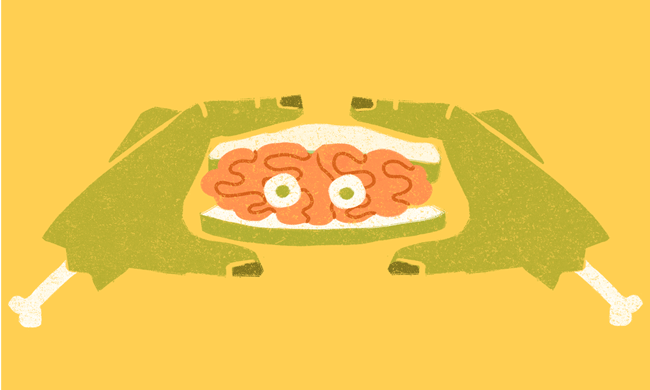Beyond the NFL: A New Plan to Treat Brain Injuries For Women Escaping Abuse

Illustration by linearcurves/iStock.
Kerri Walker has been in two relationships involving domestic violence. Like many survivors, she was hit repeatedly. She was diagnosed with a traumatic brain injury (TBI) and even suffered an aneurysm. “So when I say my brain is special, it’s special,” she says.
“But if you’ve had an injury and if you’ve had trauma in your life, that affects how your brain develops.”
Over the years, Walker, 52, has made many adjustments, including moving from a shelter in Ohio to a new life in Arizona. “We all get forgetful the older we get,” she said. “But if you’ve had an injury and if you’ve had trauma in your life, that affects how your brain develops and so you don’t go about things quite the way everybody else does.”
The last year has seen a spike of interest in TBI, due in large part to the ongoing controversy over the NFL’s handling of cases among former players, more than 40 percent of whom have exhibited symptoms of brain injury; and particularly following the 2015 release of the movie Concussion. In it, Will Smith plays Bennet Omalu, a forensic pathologist who performs the autopsy of football player Mike Webster. Omalu discovers that Webster suffered from a disorder called chronic traumatic encephalopathy, a progressive degenerative disease resulting from repeated TBIs.
Boxers, soldiers, football players: The faces of TBI are almost always those of men in dangerous or physically demanding careers. When soldiers began returning from Iraq and Afghanistan, the Department of Defense spent millions researching new technology like battlefield ultrasound machines that would help assess and treat TBIs quickly. In sports, earlier this month an appellate court affirmed a settlement that would potentially provide retired football players as much as $5 million each in damages for brain injuries. But there is another group of TBI sufferers that has been far less visible: survivors of domestic violence.
According to the Centers for Disease Control and Prevention, nearly a quarter of American women experience extreme physical violence from intimate partners during their lives. Suffering repeated blows to the head, strangulation, and being violently shaken or slammed against the wall puts them at risk for TBI. But the lack of adequate screening and identification systems means that brain injuries often go unrecognized.
That’s something advocates and researchers in Phoenix hope soon to change. The Sojourner Center, one of the largest and oldest domestic violence shelters in the United States, is partnering with the Central Arizona Center for Therapy and Imaging Services (CACTIS) Foundation, a medical research institution, to pilot the Sojourner Center BRAIN (Brain Recovery and Inter-Professional Neuroscience) Program. Through their research—starting with a study planned for May—the organizations hope to create a model for appropriate neurological care for domestic violence survivors and to document the process so that other doctors and practitioners can access data about the long- and short-term effects of TBI in women and children.
“Very little has been documented on what works and what doesn’t work,” explained Maria E. Garay, CEO of the Sojourner Center. She said the Sojourner BRAIN Program will bring to light an underreported public health epidemic and can guide best practices nationwide by producing quantifiable outcomes.
Understanding injuries
Sitting on the outskirts of Arizona’s Maricopa County, The Sojourner Center serves about 9,000 people each year. More than a shelter, the center provides counseling, medical care, a child development center, continuing education, job training programs, and more. To “accept people where they’re at,” in Garay’s words, the staff also tries to meet needs that aren’t always immediately obvious. For example, only 2 percent of domestic violence shelters in the United States provide kenneling services for pets, although 40 percent of women with pets say they are less likely to leave violent situations for fear of what might happen to their animals. So the Sojourner Center built a pet compound for cats and dogs and offered training in dog grooming. Women have come from other states to take advantage of this program.

The center’s compound for cats and dogs. Photo courtesy of the Sojourner Center.
Garay said that, because of their design, many shelters can actually exacerbate issues for women with brain injuries and PTSD. People with TBI are sensitive to light and noise; they struggle to read because of impacted eye movement. “If you have a shelter where there are tons of people and all kinds of lighting and a long intake process that has to happen, most women aren’t able to do that,” she said.
Garay believes that is what’s happening right now in domestic violence shelters across the country: Women who are unable to adapt to the systems in place are told that they’re resistant. They’re kicked out of the very shelters that are supposed to protect them. “They get rotated from one shelter to another,” she said. “Eventually what happens is they end up in the streets with their kids.”
Many shelters can actually exacerbate issues for women with brain injuries and PTSD.
Many people in these situations struggle to reset their lives without understanding the reason that even basic tasks like reading have become impossible. “I had one woman tell me that when she looked at the pages of a book and tried to read that, the words would jump around on the page and she didn’t know why,” Walker said. “The women believe what their abusers tell them. They believe that they’re stupid and that they can’t do anything right because of the repercussions of being hit in the head. Being strangled. You know, any kind of violent shaking.”
A new approach
Hirsch Handmaker, CEO of the CACTIS Foundation, believes that accounting for TBI in victims of domestic violence could result in as many as 20 million women being diagnosed—every year. “The intriguing part and the challenging part is that since no one has ever really looked at this population in an organized and methodical way from the point of assessment, there are a lot of unknowns,” he said. For the past year he and his team have been brainstorming the best way to adapt the standard assessments used on athletes to the radically different circumstances of women and children who have been victims of violence.
Accounting for TBI in victims of domestic violence could result in as many as 20 million women being diagnosed—every year.
For example, the best time to evaluate postconcussive patients is immediately after the concussion. And while athletes on the field may be examined by doctors on the spot, the situation for domestic violence survivors is more complicated. “In athletes or in the military or in first responders, generally we know exact time and nature of the head injury,” Handmaker said. “In contradistinction to that, a victim of domestic violence may arrive at an emergency room or a shelter or a police station and we don’t know whether it’s the first time that a head injury has occurred or the 50th time.”
Further complicating assessment is that effective TBI treatment often involves a third-party account of the incident—the athlete or soldier who sustains a head injury is usually not the best person to accurately give the details. “So we rely on someone who is an observer there on the field or in the vehicle to tell us when and how and what the immediate results were and what the person experienced,” Handmaker said. In most domestic violence cases, the person most qualified to relay what happened would be the person who inflicted the damage. That information source is usually out of reach.
To deal with these differences, Handmaker said the team is designing studies that are different from past concussion assessments. For example, when dealing with sports injuries, physicians normally begin with an assumption that their patients do not have a concussion. But in domestic violence cases, he said, “we want to start from the position of assuming that there has been [a TBI] and assess them using some tools that we’ve developed over the years.” The tools include a neurocognitive assessment that examines how the person sees, thinks, and interprets data. Doctors will also test for balance and issues with vision. They practice running postconcussion tests on athletes so that they have a good sense of how to do it with respect and sensitivity when it comes to women and children.
Ruth Glenn, executive director of the National Coalition Against Domestic Violence, said that this issue is only beginning to show up on the radar of practitioners and shelters around the country. “If the health care field and the domestic violence field joined forces to figure out how to make sure that those who are serving domestic violence victims were … educated in regards to TBI, I think it would help,” she said.
Glenn said women and children deserve the same concern and recognition football players have received. “We are accustomed to not having victims and survivors recognized as a group who is at risk because domestic violence is not a ‘sexy’ topic,” she said. “It’s hard to raise awareness about … just how many people are impacted by it. Why aren’t we talking about that?”






